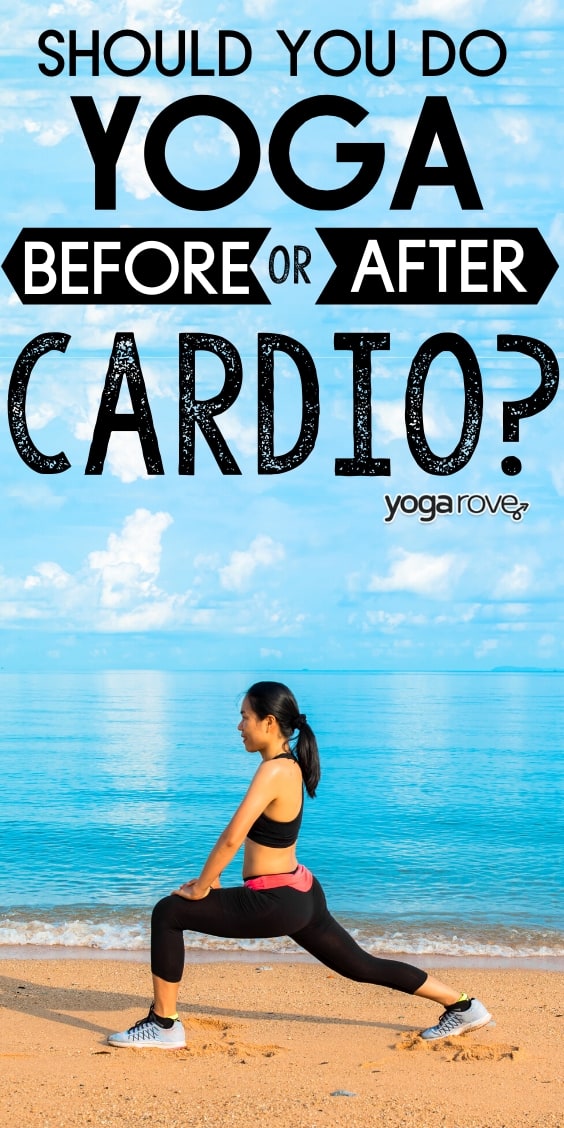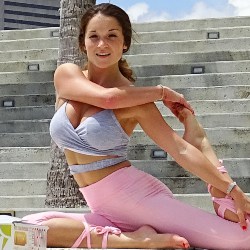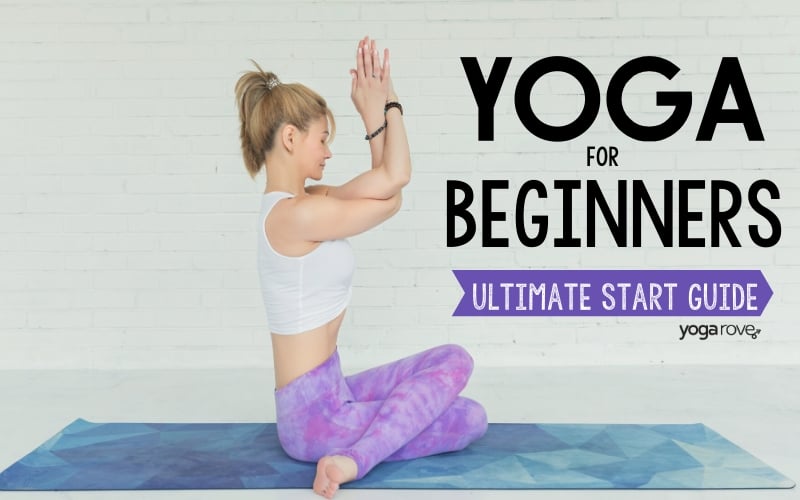This post may contain affiliate links. Please read our disclosure for more info.
As someone who enjoys a rigorous sweat in many forms of exercise, I also appreciate the flexibility of mind and body that results from a regular yoga practice and understand how yoga supports a well-rounded exercise routine. My only question is, if I’m practicing both, which one should come first?

Should you practice yoga before or after cardio? Generally speaking, you should warm up with cardio and cool down with yoga if you are taking a long, well-rounded yoga class. Most forms of yoga are meant to bring your entire body to a state of calm, so you don’t want to enter a tranquil state just to heat it up with cardio right after doing so.
In addition, cardio warms the body up to enter a more flexible state, so when you practice yoga after warming the body with cardio, you will be able to stretch deeper than if you were to start “cold” with yoga before your cardiovascular routine – this is beneficial for anyone aiming to deepen their stretches.
However, if you are practicing for 15-30 minutes, you can opt for the yoga before your cardio as a warm up that eases you into your aerobic (or weight) training – and after, as a cool down.
What If My Schedule Doesn’t Allow Me to Do Yoga After Cardio?
So your favorite spin class comes after your yoga class – that’s fine! You can view your yoga practice as a space to warm your muscles up and get your mind in the right head space to totally kill your cycling class. Just be mindful if the yoga class is a heavy vinyasa flow or high level strength class, as it may tire you out.
How Will Adding Yoga to my Regular Exercise Routine Help Me?
Many scientific studies have documented the physical and mental benefits that a yoga practice cultivates – if you are someone who constantly strives to take your physical activity to the edge, yoga is a tool that will give you the ability to do so. Whether you practice it before or after your cardio, you’ll still reap the benefits.
Studies have proven that a regular yoga practice (45-75 minutes 2 times per week or more) elicits physical health benefits in the form of increased joint flexion, increased trunk extension, and increased oxygen uptake. Not only that, but a regular yoga practice has been proven to be efficient in helping you meet your weight loss goals as well.
Keep in mind, a “regular yoga practice” includes 5-10 minutes of meditative breath work (called pranayama), followed by 30-60 minutes of dynamic movement (called asana), and finished with 5-10 minutes of supine relaxation (called savasana).
That’s not to say that you will not benefit from practicing for less time, or not meditating and breathing and instead just practicing the physical asana – it just means that if you skip or shorten some of these components, you won’t be achieving the maximum results (just like if you only ran 1 mile a day instead of 4, you wouldn’t be building your cardiovascular endurance as much).
It’s not just about increasing your abilities – it’s also about reducing disabilities. Harvard research has proven a range of improvements in the form of reductions: decreased back pain and joint/arthritis pain, lower frequency of migraines, reduced symptoms of depression, and reduced fibromyalgia pain, just to name a few.
Yoga has also proven to reduce cortisol levels, especially in women. Cortisol is often referred to as the “stress hormone” because of the way it affects the body when the body is under stress. Physiologically, it regulates your energy by selecting what substrate (protein, carbohydrate, or fat) the body needs to perform its processes; when out of whack, individuals may gain weight, crave high-calorie foods, and may experience a weakened immune system and gastrointestinal system.
Adding Yoga to Your Exercise Routine
“Yoga” literally translates to “union.” In modern day yoga practice, this is most commonly associated with union of the body and mind (though over 5,000 years ago when it started in India, it actually meant the union of the human consciousness to what their spirit believed the divine consciousness was).
This union of mind and body is achieved through meditation, breath, and movement. There are literally hundreds of styles of yoga, so if you take one class and don’t enjoy it, don’t be discouraged – instead, see if there is a different instructor or different class type or level that you can try.
What Type of Yoga is Best for Me?
1. First timer? look for a Beginner, Introductory, or Level I yoga class.
If you’re unfamiliar with the basic postures or really wary of starting a practice, look up “beginner yoga” on YouTube and practice at home until you are comfortable enough to enter a yoga class.
2. Working with Injuries? Iyengar yoga is your best bet.
K.S. Iyengar is a teacher whose focus was entirely on proper alignment of the bones and muscles, using props to achieve the correct posture without causing injury. The alignment and injury-prevention focus of this style of class is great for anyone who wants to practice and knows the limits they are working with – just give the teacher a heads up prior to the class starting and he or she will work with you accordingly.
3. Want slow and relaxing? Yin or Restorative yoga is the path to peace.
Both of these hold relaxing postures for 30 seconds to 3 minutes, and use supportive props to achieve maximum relaxation.
4. Want well-rounded, all-level?
Hatha yoga is the general “one-size-fits-all” yoga that most gyms (and studios) offer, as it’s basically the umbrella term for all yoga postures.
Expect this class to be a bit more active than a beginner class, but not as active as a Vinyasa class.
5. Need a more athletic approach that feels like a dancing flow?
If you’ve got the basics down and want a class that brings you a bit more energy and gives you the opportunity to challenge yourself, opt for a Vinyasa class.
A vinyasa class is any type of “flow” class – usually there will be Sun Salutation A and Sun Salutation B as the main flows, but the instructor will often create their own flows for the class. A yoga “flow” is a series of postures that is practiced 2 or more times in a row, repeated on each side.
6. Do you want to do the same thing, every time, and sweat buckets in the process? Visit a Bikram studio.
Bikram is a series of 26 postures in a very hot (usually heated to 105 degrees) room. If you’re taking a Bikram class, you’re usually not doing it after or before cardio – it IS your cardio (and strength and flexibility training) for the day!
7. Want to sweat buckets, but without the bootcamp style of Bikram? Visit a hot yoga studio or take a hot yoga class.
When you see “hot yoga” on the schedule (but not “Bikram Hot Yoga”), it’s usually a Vinyasa class in a heated room. Just like a regular Vinyasa class, it’s pretty athletic, but because they are flexible flows, you will have the room to play with your difficulty level.
8. Do you enjoy less physical practice, and more meditative and mantra? Give Kundalini yoga a try.
Kundalini is heavier on chanting, verbal mantras, singing, and mediation, than it is on the physical practice. It’s more of a “mind and heart” yoga than a physical body yoga practice.
How much time should I spend practicing yoga?
Any amount of time is better than no time. But, most studies have shown that practicing 45-75 minutes 2-3 times a week is most beneficial.
If you’re doing cardio on days when you’re also doing yoga, set your exercise schedule so that your “lower impact” cardio and weight days coincide with your yoga practice.
For example, I will take yoga class on the days that I’ve walked 4 miles, but not on the days that I’ve gone 4 miles on the stair master; I’ll take yoga after a dance class, but not after a rigorous boxing class (simply because my body is just too tired!).
No matter what, listen to what your body is telling you – the purpose of yoga is to connect your body and mind, so follow what feels best to YOU. You will notice that as you practice more, you will become more in-tune with your body and the feedback it gives you, whether it’s regarding your diet, physical abilities, or emotional and mental processes.
Related Questions
How do I start practicing yoga? There are tons of free resources online in so many different forms that everyone can benefit from. We have created our own Free Yoga Resource Library for you guys that is filled with free workout cards for you to print and do on your own time at home.
You can also check out our other resources we have on our blog to help you get started with your very own yoga practice:
- How to Start a Home Yoga Practice as a Beginner
- What is the First Yoga Pose You Should Learn?
- The 20 Minute Yoga Routine Every Beginner Needs
- How to Use Yoga Blocks to Improve Strength And Flexibility
Previously a dancer, Ashley has been practicing yoga for over 15 years and teaching for 5.
She balances an executive-level “corporate” position during the day with healthy, mindful wellness practices in her free time to stay grounded; she lives on celery juice and cold brew, and can’t live without her dark chocolate!







Your website is full of very useful and helpful information, especially for a beginner like me.
I got all the answer to my questions what I was looking for long on the internet.
Thanks for making such a brilliant website.
So glad you found it helpful Gayen 🙂